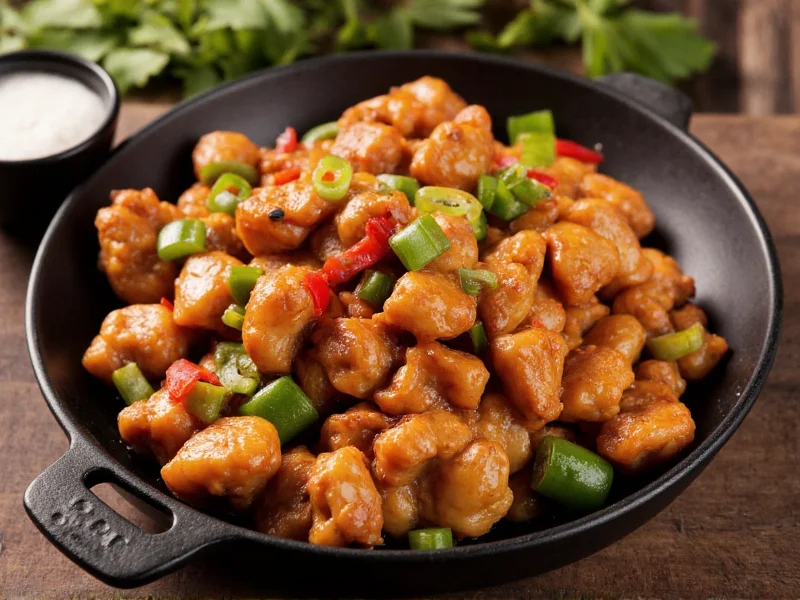Many diners confuse Kung Pao chicken and Hunan chicken because both represent fiery Chinese culinary traditions. This misunderstanding often leads to the incorrect term “kung pao hunan chicken.” Understanding the authentic characteristics of each dish enhances your appreciation of regional Chinese cuisine and helps you order or prepare these classics correctly.
Origins of Kung Pao Chicken
Kung Pao chicken (宫保鸡丁, gōng bǎo jī dīng) traces its roots to Sichuan province in southwestern China. The dish honors Ding Baozhen, a Qing Dynasty official whose title was “Gongbao.” Traditional preparation involves diced chicken stir-fried with dried red chilies, Sichuan peppercorns, and roasted peanuts. The distinctive mala flavor—that tingling, numbing sensation—comes from authentic Sichuan peppercorns, not just heat.
Authentic Kung Pao chicken balances four key elements: the fiery punch of chilies, the citrusy aroma of Sichuan peppercorns, the sweetness of sugar or hoisin, and the savory depth of soy sauce. The dish should never contain vegetables like bell peppers or carrots, which are Western adaptations. The peanuts provide crucial textural contrast to the tender chicken.
Hunan Chicken: A Different Regional Specialty
Hunan chicken (湘辣鸡, xiāng lā jī) represents the culinary traditions of Hunan province, known for its “dry heat” approach to spiciness. Unlike Sichuan cuisine's complex mala profile, Hunan cooking emphasizes fresh chili peppers—both dried and fresh—creating a more direct, penetrating heat that builds gradually.
Traditional Hunan chicken features boneless chicken stir-fried with fresh red and green chilies, garlic, ginger, and shallots in a dark soy-based sauce. The dish typically includes vinegar for brightness and sometimes fermented black beans for umami depth. Hunan cuisine avoids the numbing sensation of Sichuan peppercorns, focusing instead on pure chili heat that warms the entire body.
Key Differences Between Kung Pao and Hunan Chicken
| Characteristic | Kung Pao Chicken | Hunan Chicken |
|---|---|---|
| Region of Origin | Sichuan Province | Hunan Province |
| Signature Heat Profile | Mala (numbing-spicy) from Sichuan peppercorns | Direct, building heat from fresh chilies |
| Key Ingredients | Dried chilies, Sichuan peppercorns, peanuts | Fresh red/green chilies, garlic, dark soy sauce |
| Sauce Base | Lighter soy-based with vinegar and sugar | Dark soy-based with vinegar |
| Texture Elements | Crispy peanuts | None—focus on meat and chilies |
| Flavor Complexity | Five flavors: spicy, sweet, sour, salty, umami | Emphasis on pure heat with savory undertones |
Why the Confusion Persists
The “kung pao hunan chicken” misconception stems from several factors in Western Chinese restaurants. Many establishments simplify regional Chinese cuisine into broad categories, sometimes merging elements from different provinces. Some chefs create fusion dishes combining Sichuan and Hunan techniques, while others lack authentic training in either regional specialty.
When restaurants serve what they call “kung pao hunan chicken,” they typically present a Hunan-style dish with added peanuts—an element that doesn't belong in authentic Hunan cooking. This hybrid version satisfies neither traditional preparation nor regional authenticity, though it may appeal to diners seeking maximum heat without the mala sensation.
Identifying Authentic Versions
To recognize genuine Kung Pao chicken, look for the telltale Sichuan peppercorns (usually left whole in the dish) and roasted peanuts. The sauce should coat the chicken without being overly thick or sweet. Authentic versions never include bell peppers, broccoli, or other vegetables not found in traditional Sichuan home cooking.
For authentic Hunan chicken, expect a darker-colored sauce with visible fresh chilies and garlic. The heat should build gradually rather than hitting immediately, and you shouldn't experience any numbing sensation. Traditional Hunan chicken contains no peanuts or cashews—these additions indicate Americanized interpretation.
Cultural Significance in Chinese Cuisine
Both dishes represent China's regional culinary diversity, where geography and climate shaped distinct cooking styles. Sichuan's humid climate inspired the mala flavors that help cut through moisture, while Hunan's hot summers led to dishes that induce sweating to cool the body. Understanding these cultural contexts enriches your dining experience beyond mere heat levels.
In China, these dishes remain distinctly separate with clear regional identities. The confusion primarily exists in Western markets where Chinese cuisine is often homogenized. By recognizing their differences, you honor the culinary heritage of both regions and make more informed choices when ordering or cooking.
Practical Tips for Home Cooking
When preparing authentic Kung Pao chicken at home, source proper Sichuan peppercorns (not substitutes) and use roasted, unsalted peanuts. The chilies should be toasted before stir-frying to release their oils. For Hunan chicken, select fresh red and green chilies—not dried—and don't skip the garlic, which forms the flavor foundation.
Both dishes require high-heat wok cooking for proper “wok hei” (breath of the wok) that can't be replicated in standard Western pans. Marinate the chicken briefly in cornstarch and rice wine before cooking to ensure tenderness. Remember that authentic Chinese cooking builds flavors sequentially—garlic and chilies first, then protein, then sauce.











 浙公网安备
33010002000092号
浙公网安备
33010002000092号 浙B2-20120091-4
浙B2-20120091-4